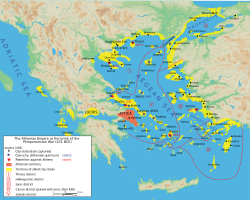Classical antiquity
Classical antiquity (also the classical era or classical period) is a broad term for a long period of cultural history around the Mediterranean. It includes the civilizations of Ancient Greece and Ancient Rome, known as the Greco-Roman world.
Classical antiquity is the period in which Greek and Roman literature (such as Aeschylus, Ovid, and others) flourished.[1] By convention, the period starts with the works of Homer, (8th–7th century BC), and ends with the arrival of Christianity and the decline of the Roman Empire (5th–6th century AD).
Archaic period (8th to 6th centuries BC)
- Further information: Iron Age
The earliest period of classical antiquity took place before the re-appearance of historical sources after the Bronze Age collapse. The earliest Greek alphabetic inscriptions are in the first half of the 8th century. Homer is usually assumed to have lived in the 8th or 7th century, and his lifetime is often taken as marking the beginning of classical antiquity. The traditional date for the first Ancient Olympic Games, in 776 BC, was also around this time. In Roman legend, the city of Rome was founded in 753 BC. The earliest settlement at the Roman Forum seems to have taken place around this time.
Phoenicians
The Phoenicians originally expanded from Levantine ports, by the 8th century dominating trade in the Mediterranean. Carthage was founded in 814 BC, and the Carthaginians by 700 BC had firmly established strongholds in Sicily, Italy and Sardinia, which brought about conflicts of interest with Etruria.
Greece
The Archaic period followed the Greek Dark Ages, and saw the rise of democracy, philosophy, theatre, poetry, as well as the revitalisation of the written language (which had been lost during the Dark Ages).
Pottery styles of the later part of the Archaic age are the black-figure pottery, started in Corinth during the 7th century BC. Its successor was the red-figure style, developed by the Andokides in about 530 BC.
Classical Greece (5th to 4th centuries BC)


The classical period of Ancient Greece was from the fall of the Athenian tyranny in 510 BC to the death of Alexander the Great in 323 BC. During this period cane the long struggle between Sparta and Athens, and the wars between the Greeks and the Persians. The rise of Macedon in the 4th century overturned all other political systems, at least for a while.
Hellenistic period (330 to 146 BC)
The Hellenistic period began with Alexander, when Greek became the lingua franca far beyond Greece itself, and Hellenistic culture came in contact with the cultures of Persia, Central Asia, India and Egypt. The Hellenistic period ended with the rise of the Roman Republic to a super-regional power in the 2nd century BC and the Roman conquest of Greece in 146 BC.
Roman Republic (5th to 1st centuries BC)
The Roman Forum was the central area around which ancient Rome developed.
- Further information: culture of ancient Rome
The republican period of Ancient Rome began with the overthrow of the Monarchy at about 509 BC and lasted over 450 years until its subversion, through a series of civil wars and the Imperial period.
Roman Empire (1st century BC to 5th century AD)
Determining the precise end of the Republic is a matter of dispute.[2] Roman citizens of the time did not recognize that the Republic had ceased to exist.
It could be said that Rome was already of imperial character. It had no emperor when it conquered Gaul, Illyria, Greece Hispania, and the Roman province of Asia.
Late Antiquity (4th to 6th centuries AD)
During Late Antiquity Christianity rose under Constantine I, and finally became the Roman imperial cult in 393. Successive invasions of Germanic tribes meant the end of the Western Empire in the 5th century, but the Eastern Empire persisted throughout the Middle Ages as the Byzantine Empire.
Revivalism
- Further information: Renaissance and Classicism
Respect for the ancients of Greece and Rome affected politics, philosophy, sculpture, literature, theater, education, architecture and even sexuality.
In politics, the presence of a Roman Emperor was felt to be desirable long after the empire fell. This tendency reached its peak when Charlemagne was crowned "Roman Emperor" in the year 800, an act which led to the formation of the Holy Roman Empire. The notion that an emperor is a monarch who outranks a mere king dates from this period. In this political ideal, there would always be a Roman Empire, a state whose jurisdiction extended to the entire civilized western world.
Subtopics
Related pages
- Kofun period (Japan, 250 CE – 538 CE)
- Asuka period (Japan, 538 CE – 710 CE)
Notes
- ↑ Fargis, Paul (1998). The New York Public Library Desk Reference - 3rd Edition. Macmillan General Reference. p. 262. ISBN 0-02-862169-7.
- ↑ The precise event which signaled the transition of the Roman Republic into the Roman Empire is a matter of interpretation. Historians have proposed three key events: the appointment of Julius Caesar as perpetual dictator (44 BC); the Battle of Actium (2 September 31 BC); and the Roman Senate's grant of Octavian's extraordinary powers under the first settlement (January 16, 27 BC).
References
- Grinin L.E. 2008. Early states in the classical world: statehood and ancient democracy. In Grinin L.E. et al. (eds) Hierarchy and power in the history of civilizations: ancient and medieval cultures. Moscow: URSS. [1]

